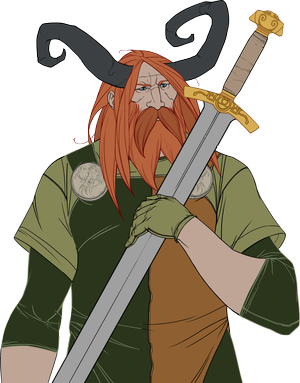The Banner Saga is a game of visual poetry and verbal mush. There’s music in its journey but none in the ordinary talk of its travelers, whose voices come from the bottom shelf of the fantasy section. Its hand-drawn world is alive with accents and scrollwork: wooly faces looming on Godstone monuments, fingers drumming the rim of a shield, the long gold edge of the red banner Alette mends on the menu screen. But the developers never found a golden thread to pass through the unruly pieces of their own design, something that would make turn-based tactics and Oregon Trail and King of Dragon Pass look at home together.

Instead of bringing the game’s ambitions into focus, the script nearly stifles them. Early lines like “Vognir came to our capital in Arberrang and now will go to the varl’s capital in Grofheim” only make you feel more lost. And once you know your Vognirs from your Yngvars, the glut of text is unwelcome. Notes like “An ominous feeling lingers as you prepare to enter the great hall” do nothing but spell out what slanting steps and keening wind already imply. The suggestions of the art can feel halfway snowed in by all the explanation piling up at the bottom of the screen, and the narrow eyes and curling beards of the character portraits speak louder than the script.
The game feels most at home on quiet stretches of road, in the caravan sections that cover miles of sumptuous illustration. The scenery rolls by like rear projection as your host trudges westward, maintaining a contemplative pace (you cannot set it to “grueling,” in a departure from Oregon Trail). It feels like the revenge of a game artist radicalized by the knowledge that a million players had rushed past his best work: you’ll study it now, fuckers. You’ll spend your time admiring bare white trees and broken stones because there is absolutely nothing else to do. But it turns out to be more rewarding to treat nature as an art gallery than the treasure hunt most games make of it.
By unspooling their landscape so deliberately behind the wagon train, the designers give the land more character than the figures marching across it. It’s harder to watch their peacefully scrolling world end than it is to take in an ordinary videogame apocalypse, because this is the destruction of a familiar place. The caravan view is Banner Saga’s best idea, and it reaches a wild peak in the game’s last minute, when the rolling world comes to a final stop and Wintory’s theme thunders like it’s going to crack the screen in half.
Yet the caravan sections are less than a third of the game, and they’re not of a piece with the rest of it. The animations used in Banner Saga’s battles are achingly fine, and the bloody coughs of the wounded are well voiced, and the score is often thrilling, but fighting is a chore. The enervating combat system dissipates the momentum built on the march to Boersgard with long nibbling battles that don’t match the desperate pitch of the story. The hills and chasms seen while traveling are gone, mashed down into plain grids that dearly miss wrinkles like high ground and chokepoints. The distended pecking matches played on this board feel like part of a different game, which they are.

Rather than letting teams move together XCOM-style, or deciding turn order through character stats, Banner Saga sticks to a rigid alternation of turns between members of opposite teams. Killing enemies gives more turns to their fellows, because the game will never allow your team to take two turns in a row. This rather abstract mechanic drags out fights that are all but won (particularly against Slingers, who move backward whenever you hit them). It also saps the coherence of the game’s fiction: a colossal Stoneguard Defender shouldn’t move three times as fast as your nimble little archer, even if a lot of his friends are dead.
Combat takes an even stranger turn thanks to another key mechanic, which weakens units’ attacks as they lose health. This means that maimed enemies are sometimes more useful alive than dead, because the toothless rascals will keep wasting their side’s turns to rub their gums on your armor. It’s funny the first time you build one of these feeble crowds and fire at some frustrated killing machine stuck on the other side. But the mechanic reduces what should be a desperate struggle to a numbers game. Safely declawing your foes by adjusting their health and armor totals is perhaps the most un-Viking activity imaginable; it feels more like managing the stock in a warehouse. The game bellows “Pillage!” when only one enemy remains, but knocking that last guy down feels no more triumphant than punching a clock.
After you work through hours of mostly rote combat, Banner Saga finally takes advantage of its unusual systems in a boss fight that is simply murder. It’s meant to be a battle out of legend, and for once it feels like one: on Normal, it is colossally unfair. The enemy, a red titan who seems to be shaking himself apart with rage, heals with every turn and gets a free attack whenever he takes damage. His presence turns the last battle into the desperate struggle that all of the game’s fights should have been, and forces you to use every spacing and maiming trick you know just to stand a chance. When you finally have him on the ropes, the trumpets on the soundtrack get hysterical, cutting the oppressive mood to ribbons.
The moment when Banner Saga starts to make sense is basically the last minute of the game. It gathers its meandering thoughts into a forceful statement at last, but that message doesn’t redeem all the wasted breath before it. The game winds up in a neat place, but it’s a shame about the road you take to get there.
